About the Tutor-Student Relationship
Because learning to read involves building and strengthening neural pathways, it can be hard work. Research has shown that for about 5% of people, reading comes easily—their brains just seem to be wired for it. For the rest of us, our brains work hard to re-wire for reading, a skill that our early human ancestors did not evolve with. Not only can most people benefit from some explicit instruction in how to read, about 65% of us will struggle to read, spell, or write well without explicit instruction. And more than a third of that group CANNOT learn to read without systematic, explicit, repetitive instruction. Unfortunately, this process isn’t well understood by most U.S. classroom teachers or parents and thus some children fall behind in reading very early. By first grade they may already be suffering from low self-esteem and a fear of failure because reading has been so difficult for them. Homeschooled children may be better protected from the shame their school-going peers feel, but eventually it may become clear that they are struggling to read and again, for a large percentage of them reading isn’t going to “come naturally”.
Any person who has struggled to read needs an emotionally safe environment to learn in. The Brain Friendly Reading approach emphasizes minimizing stress, carefully scaffolding instruction so students feel the right balance of challenge and success, and using games to make meaningful repetition fun.
These are also features of the instructional model I’ve used for years as a nature connection mentor. As a tutor or mentor, connection to my student is always my primary tool. I understand how to support a struggling reader with empathy, patience, and encouragement. I teach them a bit about how their brain works so they know that their reading difficulty doesn’t mean they aren’t intelligent and we are going to work together to re-wire their brain for reading. Through constant observation, I assess what the student knows and what is still difficult for them and tailor the lesson to the individual.
I also have the ability to connect with people from cultures other than my own. Two years in the Peace Corps after college and time spent living and working in Mexico, Canada, Thailand and many places in the U.S. have taught me to try not to make assumptions based on my own cultural biases. I enjoy getting to know people of all backgrounds and learning from my students. I speak conversational Spanish.

